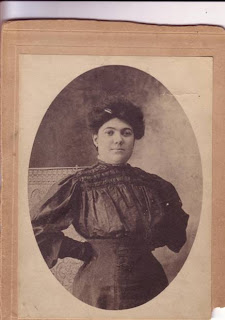Last week, out of the blue, Bowery Boogie sent me an email - a Mr. Allen Kurtz had read on that blog about the Tenement Museum's research into 103 Orchard Street and wrote in to say, "My wife's family lived in that building from 1904 to 1910." As if that weren't cool enough on its own, Mr. Kurtz then sent along an extensive family history, charting the Begechers' arrival in the United States and their path through 103 Orchard Street and beyond.
I'm very happy to share that history with you this week. What's wonderful is how typical this immigrant experience is... and yet so personal to this distinct family.
Special thanks to Bowery Boogie.
The Begechers of 103 Orchard Street
By Alan Kurtz
In many ways, the Begechers (Marcus, Sarah, and their six children, Chaya, Liebe, and Ruchel, Mendel, Schema, and Schnerza) were typical Eastern European Jewish immigrants. Originally from Botosani, a small city in what is today northeast Romania, they more likely than not came to the United States to escape a life severely limited by persecution, oppression, and grinding poverty.
Not able to afford passage for the family to depart for America as an intact unit, the Begechers arrived in dribs and drabs as if a human chain; one saving up hard earned dollars to purchase passage for the next. Consequently, family members were often separated for months if not years.
Though it cannot be proven with complete accuracy, Chaya (who would subsequently Americanize her name to Ida) was likely the first to arrive, possibly sometime in 1898. Because she was still a child, perhaps as young as eight years of age, she came to America not in steerage, but as a Second Class passenger.
As steamship lines were not required to record their “better heeled” First and Second Class passengers on official manifests until 1903, her exact arrival date is not known, and it may be that she didn’t arrive until 1901.
Similarly, the name of the person who accompanied her to America is a perplexing mystery. What is known is that the man, who Ida would describe later in life as either an agent or an “uncle,” was quite protective of her and would not let her go down to steerage to meet other young passengers. As a result, she had no one to play with. All the while, she suffered from seasickness.
Ida Begecher Katz, later in life. Courtesy Alan Kurtz.
Her passage was paid for by her aunt and uncle, Celia and Louis Bralower of 50-52 Hester Street, who owned a thriving dry goods business. Their company, established in the 1880s, would survive for nearly 100 years.
Immediately after arrival, Ida was put to work in their shop to pay off her passage. Ida’s sister Liebe, who would later change her name to Lilly, may have arrived shortly thereafter. Her arrival manifest has also not been located.
To be continued tomorrow... as the rest of the family arrives in America.
- posted by Kate


No comments:
Post a Comment
Note: Only a member of this blog may post a comment.